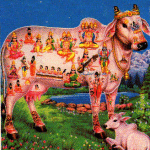HINDUISM: COW EATING (English)
Cow Eating from the Hinduism Books
Hinduism and Cow Eating are related even the Hindus deny this today but that is the truth. Lets explore some Hindu Books in this article.
Manusmriti (5 / 35) states: When a man who is properly engaged in a ritual does not eat meat, after his death he will become a sacrificial animal during twenty-one rebirths.
Maharishi Yagyavalkya says in Shatpath Brahmin (3/1/2/21) that, “I eat beef because it is very soft and delicious.”
Apastamb Grihsutram (1/3/10) says, “The cow should be slaughtered on the arrival of a guest, on the occasion of ‘Shraddha’ of ancestors and on the occasion of a marriage.”
Rigveda (10/85/13) declares, “On the occasion of a girl’s marriage oxen and cows are slaughtered.”
Rigveda (6/17/1) states that “Indra used to eat the meat of cow, calf, horse and buffalo.”
Vashistha Dharmasutra (11/34) writes, “If a Brahmin refuses to eat the meat offered to him on the occasion of ‘Shraddha’ or worship, he goes to hell.”
Hinduism’s greatest propagator Swami Vivekanand said thus: “You will be surprised to know that according to ancient Hindu rites and rituals, a man cannot be a good Hindu who does not eat beef”. (The Complete Works of Swami Vivekanand, vol.3, p. 536).
· Mukandilal writes in his book ‘Cow Slaughter – Horns of a Dilemma’, page 18: “In ancient India, cow-slaughter was considered auspicious on the occasions of some ceremonies. Bride and groom used to sit on the hide of a red ox in front of the ‘Vedi’ (alter).”
A renowned scholar of scriptures Dr. Pandurang Vaman Kane says, “Bajsancyi Samhita sanctifies beef-eating because of its purity”. (Dharmashastra Vichar Marathi, page 180)
· Adi Shankaracharya’ commentary on Brihdaranyakopanishad 6/4/18 says : ‘Odan’ (rice) mixed with meat is called ‘Mansodan’. On being asked whose meat it should be, he answers ‘Uksha’. ‘Uksha’ is used for an ox, which is capable to produce semen.
· The book ‘The History and Culture of the Indian People’, published by Bhartiya Vidya Bhawan, Bombay and edited by renowned historian R.C.Majumdar (Vol.2, page 578) says: “this is said in the Mahabharat that King Rantidev used to kill two thousand other animals in addition to two thousand cows daily in order to give their meat in charity”.
[Mahatma] Gandhi himself says, “I know there are scholars who tell us that
cow-sacrifice is mentioned in the Vedas. I… read a sentence in our Sanskrit
text-book to the effect that Brahmins of old [period] used to eat beef” [M.K.
Gandhi, Hindu Dharma, New Delhi, 1991, p. 120]
Hymn CLXIX of the Rig Veda says:
“May the wind blow upon our cows with healing; may they eat herbage …
Like-coloured various-hued or single- coloured whose names through sacrifice
are known to Agni, Whom the Angirases produced by Ferbvour – vouschsafe to
these, Parjanya, great.protection. Those who have offered to the gods their
bodies whose varied forms are all well known to Soma” [The Rig Veda (RV),
translated by Ralph H. Griffith, New York, 1992, p. 647].
In the Rig Veda (RV: VIII.43.11) Agni is described as “fed on ox and cow”
suggesting that cattle were sacrificed and roasted in fire. Another hymn (RV:
X.16.7) mentions the ritual enveloping of the corpse with cow flesh before
applying the fire on it.
In the Brahmanas at 1.15 in the Aiteriya Brahmana, the kindling of Agni on the
arrival of King Some is compared to the slaughter of a bull or a barren cow on
the arrival of a human king or other dignitary (But now punishable by the Laws
passed by Hindu BJP Lunatics)
Similarly, at II.1.11.1 in the Taiteriya Brahmana and XXXI.14.5 in the
Panchavinsha Brahmana, the rishi Agastya is credited with the slaughter of a
hundred bulls.
In verse III.1.2.21 in the Satapatha Brahmana, sage Yajnavalkaya asserts that
even though the cow is the supporter of everyone, he would eat beef “if it is
luscious.” At IV.5-2.1 in the same Brahmana, it is said that a barren cow can
be slaughtered in the Some sacrifice. Not only for religious purposes, but also
for other purposes one could kill a cow and eat beef. Thus at II.4.2 of the
same Brahmana, it is suggested that a fat bull or fat goat
should be sacrificed in honour of an important guest.
Manu Smruti that is; chapter 5 verse 31 says “EATING MEAT IS RIGHT FOR THE SACRIFICE, THIS IS TRADITIONALLY KNOWN AS A RULE OF THE GODS”
Similarly, the Brihadaranyaka Upanishada (VI.4.18) advises a couple to take an
evening meal of beef or veal pulao,and have bull and cow like sex if they
desire to beget a son who is learned in the Vedas [Robert Trumbull, As I see
India, London, 1957, p.241].
Manu Smruti chapter 5 verse 39 and 40 says
“GOD HIMSELF CREATED SACRIFICIAL ANIMALS FOR SACRIFICE… THEREFORE KILLING IN A SACRIFICE IS NOT KILLING.”
Manu Smruti even narrates the supremacy of killing animals in sacrifice it is mentioned in chapter 5 verse 42
“A TWICE BORN (A BRAHMIN) WHO KNOWS THE TRUE MEANING OF VEDAS AND INJURES SACRIFICIAL ANIMALS FOR CORRECT PURPOSES CAUSE BOTH HIMSELF AND THE ANIMAL TO GO TO THE HIGHEST LEVEL OF EXISTENCE”.
Rig-Veda book 10 Hymn 27 verse 2:
“THEN WILL I, WHEN I LEAD MY FRIENDS TO BATTLE AGAINST THE RADIANT PERSONS OF GODLESS, PREPARE FOR THEE AT HOME A VIGOROUS BULLOCK, AND POUR FOR THEE THE FIFTEEN FOLD STRONG JUICES”
Rig-Veda book 10 Hymn 28 verse 3:
“0 INDRA, BULLS THEY DRESS FOR THEE, AND OF THESE (MEAT) THOU EATEST WHEN MAGHAVAN, WITH FOOD THOU ART INVITED”.
Rig-Veda bock 10 Hymn 16 verse 10
“I CHOOSE AS GOD FOR FATHER-WORSHIP AGNI, FLESH EATER, WHO HATH PAST WITHIN YOUR DWELLINGS”.
Atherva-Veda book 9 Hymn 4 verses 37-38-39
“THE MAN SHOULD NOT EAT BEFORE THE GUEST WHO IS BRAHMIN VERSED IN HOLY LORE WHEN THE GUEST HATH EATEN HE SHOULD EAT. NOW THE SWEETEST PORTION, THE PRODUCE OF COW, MILK OR FLESH, THAT VERILY HE SHOULD NOT EAT (before the guest)”
Mahabharata Shanti Parva chapter 29:
“ALL THE VESSELS AND THE PLATES, IN RANTIDEVA’S PALACE, FOR HOLDING FOOD AND OTHER ARTICLES, ALL THE JUGS AND OTHER POTS, THE PAN AND PLATES AND CUPS, WERE OF GOLD. ON THOSE NIGHTS DURING WHICH THE GUESTS USED TO LIVE IN RANTIDEVA’S ABODE,TWENTY THOUSAND AND ONE HUNDRED KINE {COWS} HAD TO BE SLAUGHTERED. YET EVEN ON SUCH OCCASIONS, THE COOKS, DECKED IN EAR-RINGS, USED TO PROCLAIM (AMONGST THOSE THAT SAT FOR SUPPER) “THERE IS ABUNDANT OF SOUP, TAKE AS MUCH AS YOU WISH, BUT OF FLESH WE HAVE NOT AS MUCH TODAY AS ON FORMER OCCASIONS”
Mahabharata Anushashan Parva chapter 88:
(ceremony of dead) to keep them satisfied Paragraph reads as follows (ancestors) during the Dharmaraj Yudhishthira and Pitamah Bhishma about what food one should offer to
“Yudhishthirn said, “0 thou of great puissance, tell me what that object is which, if dedicated to the pitris (dead ancestors), become inexhaustible! What Havi, again, (if offered) lasts for all time? What, indeed, is that which (if presented) becomes eternal?”
also, thus offered, prove inexhaustible, offered to the pitris on anniversaries of the lunar days on which they died, becomes inexhaustible. The potherb called Kalaska, the petals of Kanchana flower, and The the gratification of pitris lasts for twelve years. With the presented at the Shraddha, their gratification, it is said, lasts for a full year. Payesa mixed with ghee is as much acceptable to the pitris as their gratification lasts for eleven months. With for ten months. With the meat of the that are called Prishata, they remain gratified for eight months, and with that obtained form the Ruru for nine months, and with the meat of With venison obtained from thosefor seven.for six months, and with the with the for four months, with thethey remain gratified for three months and with the offered at Shraddha, the pitris remain gratified for a period of two months. With the”Bhisma said, Listen to me, 0 Yudhishthira, what those Havis are which persons conversant with the rituals of the Shraddha (the ceremony of dead) regard as suitable in view of Shraddha and what the fruits are that attach to each. With sesame seeds and rice and barley and Masha and water and roots and fruits, if given at Shraddhas, the pitris, 0 king, remain gratified for the period of a month. With
So but natural if you want to keep your ancestors satisfied forever, you should serve them the meat of red goat.
.
In Shraddha (ceremony of dead) even Brahmjn priests are expected to eat meat. Manu Smruti instructs Hindus to serve non-vegetarian food to priests i.e. Brahmins. It says in CHAPTER 3 VERSES 226 AND 227
“Purified and with a concentrated mind, he should put down on the ground before (THOSE PRIESTS)seasoned foods like soups and vegetables and also milk, yogurt, clarified butter, honey and various foods that are eaten and enjoyed, roots and fruits, TASTY MEATS, and fragrant water
IN VISHNU DHARMOTTAR PURAN BOOK 1 CHAPTER 140 VERSES 49 & 50 SAYS
“THOSE WHO DO NOT EAT MEAT SERVED IN THE CEREMONY OF DEAD (SHRADDHA), WILL GO TO HELL (NARAK)”.
In Manu Smruti Chapter 5 verse 35 it says
“BUT WHEN A MAN WHO IS PROPERLY ENGAGED IN A RITUAL DOES NOT EAT MEAT, AFTER HIS DEATH HE WILL BECOME A SACRIFICIAL ANIMAL DURING TWENTY-ONE REBIRTHS”
ON PAGE 174 ,
THE SWAMI SAYS, “THERE WAS A TIME IN INDIA WHEN A BRAHMIN COULD NOT BE A BRAHMIN IF HE DID NOT EAT BEEF.”
“YAJ VISHESHAH ATRA ESTRIGOPASHUH MANTRESHU ESTRILINGPATHET TASYA LAKSHANAM – SATPASHLATWA – NAY SHAFATWA- BHAG SHRINGATWA – KANATWA – CHHINNKARNTWA- DIDASHRAHITYAM. TASYA PRAYOGAH SARVO APEE CHHAGPASHUAWAT. YAJMAMSYA SWARGAH FALAM GOSCHA GOLOKO PRAPTEE.”
“This is the special yagya. In this yagya, the cow is sacrificed. In this ‘mantra’ the word ‘go’ is used for cow, and not for ox or calf because the verse suggests the feminine gender the cow, worthy for sacrifice in this yagya, should have seven or nine hoofs. Its horns must be intact. It should be neither one-eyed, nor ear-cropt It should be treated like a goat. The performer of ‘Gomedh Yagya’ attains heaven and the cow scarified in this yagya goes to “Golok.”
“UDEECHINA ASYA PADO NIDHTTAT SURYA CHAKSHURGAMYATATT WATAM PRAMMANV VASRIJTAT ANTRIKSHAMASAM DISHAH SHROTRAM PRITHIVIM SHARIRMITYESHWAIWAIN TALOOKESHWADDHATI.
EKDHAASYA TWACHAMACHCHH YATTATAM PURANABHYA APISHASOMU WAPAMUTIKHADATA DANTREVOSHMANAM WARYDHADITI PASHUSHVEV TAT PRANANAM DADHOTI.
SHAYENMASYA VAKSHAH KRINUTAAT PRASANSHA BAHUSHALA DOSHNI KASHYEWANSACHICHHDRE SHRONI KAWSHORUSTEKPARUNADASHTHIWNA KSHARVINSHATIRUSYAWADD KRAYAFU ANUSTHYO CHAYAWYATAD GAATRAM GAATRAMASYA NUNE KRINUTADETYAMGAANYEWATYA TAD GAATRANI PREENAATI… UWADHYAGOHAN PARTHIWAM KHANTAD… ASNA RAKSHA SAMSRIJATADITYAH-ETERIYA BRAHMIN 2/6/6-
That is, ”Turn its feet towards north. Offer its eyes to the sun, its breath to the air, its life (pran) to the space, its hearing power to the directions and its body to the earth. In this way, the priest enjoins the animal to the ‘parlok’ (heaven)”
“Flay its whole hide in one piece. Pierce the rnembrane of its intestines before cutting its navel. In this way, the priest infuses breath into the animals”
“Now cut a piece from its chest in the shape of an eagle, two pieces from its arms in the shape of an axe, two pieces from its legs in the shape of paddy-ears, the intact part of its back, two pieces from its thighs in the shape of a shield, two pieces from its two knees in the shape of leaves and its 26 ribs. Its every part should be kept safe. Dig a pit to hide its dung. Offer its blood to the ghosts.”
UTTAHMADIM PEEV EDUBHA KUKSHEE PRINNANTI ME VISHWASMADINDRA UTTAR -The Rigveda 10/86/14
“INSPIRED BY INDRANI (THE WIFE OF INDRA), THE PERFORMERS OF THE YAGYAS SACRIFICE 15 OR 20 OXEN AND COOK THEIR MEAT FOR ME. EATING THESE ANIMALS I AM GETTING FAT.
MITROKRUWOO YACHCHHSEN NO GAWAH PRITHIVYA APRIGMUYA SHAYANTI
“0 INDRA! MAY ALL THE DEMONS CUT BY YOUR WEAPON ON THE EARTH AS THE COWS ARE CUT AT THE PLACE OF SLAUGHTERING.”
‘VIVAH SUKTA’ (10/85) OF THE RIGVEDA, DR. V.M. APTE WRITES ON PAGE 387 OF ‘THE VEDIC AGE’, A BOOK PUBLISHED UNDER THE AEGIS OF BHARATIYA YIDYA BHAWAN:
says, VEDIC INDEX, VOL.2, PAGE 145
AGNERVARMAR PARIN GOBHIRVYAYSWA SAM PRONUSHWA PEEWSA MEDSA CHA -The Rigveda, 10/16/7
‘THAT IS,” 0 DEAD, HAVE THE SHIELD OF FIRE-FLAME WITH ‘GODHARMA’. MAY YOU BE COVERED WITH MEAT”
‘VEDIC DICTIONARY’ OF BANARAS HINDU UNIVERSITY; “POSSIBLY, THE COW-SLAUGHTERING WAS NECESSARY AT THE FUNERAL (DAH SANSKAR) OF HUMANS. HERE IS THE DESCRIPTION OF COVERING THE DEAD BODY WITH BEEF.”
WAH VAPAM JATTVEDAH PITRITHYO YTRAINANVETATHNIHITANPARAKE MEDASAH KILYA UPP TANSTRAWANTU SATYA ESHAMASHISHAH SANNAINTAN SWAHA -YAJURVED6 35/20
“THAT IS, “0 JATDEVA, TAKE THIS PARTICULAR HIDE OF COW. YOU KNOW THE ANCESTORS MAY THE RIVERS OF FAT OF THAT PARTICULAR HIDE FLOW TOWARDS THE ANCESTORS AND THE DESIRES OF THOSE, WHO DONATE FOR THEIR ANCESTORS, BE FULFILLED.”
ASHNMUYEW AHAM ANSALAM CHEDDA BHAWTITI.
“EAT THE MEAT WHICH IS MORE SOFT.”
DUHAIMIMISHIBHYAM PAGO AGHNY£YAM SA WARDHANTA MAHTE SAUBHAGAM. -THE RIGVEDA III 64/27
Here the word ‘Imam’ indicates a particular kind of cow. The ‘VEDIC DICTIONARY’ of Banaras Hindu University says that the cows were killed, no matter they were called ‘Aghanya’. A renowned scholar of scriptures, DR. PANDURANG VAMAN KANE says, “THAT WAS NOT THE CASE. VAJSANEYI SAMHITA SANCTIFLES THE BEEF-EATING BECAUSE OF ITS PURITY.” (DHARMASHASTRA VICHAR MARATHI, PAGE 180).
“SWAMI VIVEKANAND TOLD THE CONSERVATIVE BRAHMINS VERY ENTHUSIASTICALLY THAT IN THE VEDIC PERIOD BEEF-EATING WAS IN COMMON USE. ON BEING ASKED ABOUT THE ‘GOLDEN ERA’ OF INDIAN HISTORY, THE SWAMI NAMED THE VEDIC PERIOD WHEN ONLY FIVE BRAHMINS WERE SUFFICE TO EAT A COW.” (FOR REFERENCE SEE ‘VIVEKANAND: A BIOGRAPHY’, PAGE 96.)
BRIHDARANYAKOPANISHAD (6/4/18):
ATHA YA ECHCHHATEPUTRO ME PANDITO VEGEETAH SAMTINGAM SHUSHRUSHITAM VACHAM BHASHITA JAYETI. SARVANVEDANNUBABREET SARVAMAYURIYADITI MANSAUDANAM PACHYEETWA SARPEESHMANT AMSHANIYYATUMISHAWARO JANYEETWA ANKSHEN WARSHVEN WA. – BRIHDARNYAKOPANISHAD [6/4/18]
“A man, who wishes his son, yet to born, to be a great orator, a great scholar of the Vedas and of 100 years of age. should eat along with his wife the meat of an ox or bull mixed with ghee and ‘bhat’ (rice).”
In the Sundara Kanda, the 36th sarga, the 41st sloka describes how Hanuman tells Sita, ” When you were away, Sri Rama refrained from eating deer meat.”
ADI SHANKARACHARYA, THE GREATEST PROPAGATOR OF HINDUISM, SAYS THUS IN HIS COMMENTARY OF BRIHDARANYAKOPANISHAD:
MANSMISHRIOMODANAM MANSAUODNAM. TANMAMSANIYAM -ARTHMAHAUKSHEN WA MANSEN UKSHA SEWANSAMARTHA PUNGWASTDIYAM MANSAM. RISHBHASTETATOAPYADHIKVYAST -DEEY MA SHA BHAM MANSAM. -ADI SANKRACHARYA’S COMMENTRY ON BRIHDARANYAKOPANISHAD[6/4/18]
That is, ‘Odan’ (rice) mixed with meat is called ‘MANSODAN’. On being asked whose meat it should be, he answers ‘UKSHA’. ‘Uksha’ is used for an OX, which is capable to produce semen. Therefore, I suggest the Hindu brothers, who want to know truth about beef-eating as against the true spirit of Hinduism, to study the commentary of ADI SANKRACHARYA on BRIHDARANYAKOPANISHAD
SANTASARAM GAVYEN PREETI, BHUYAMSAMTTO MAHISHEN ETTEN GRAMYARKHYANAM PASHUNAM MANSAM MEDHYAM VYAKHYATTAM. KHARGOPASTREN KHARGAMANSENANTYAM KALAM. TATHA SHERTBALERM ARTSYASYES MANSEN WAGHREENSASYA CHA -APASTARRIB DHARNTASUTRA [2/7/16/25, 2/7/17/3]
GAVAYEN DATTARN SHRADHE TU SANWATASARMIHOCHCHAYATTE.
-MAHABHARAT, ANUSHASAN PARVA 88/5
‘The ancestors are appeased for one year on being served with beef on the occasion of their ‘Shraddha’.
ALABHYATE SHATAM GAWAM SAHASIRANI CHA VINSHATIH-Mahabharat; Shanti Parva 29/179
HAVEESHYAMATSYAMANSAIASTU SHASHASYA NAKULASYA CHA. SAUKARCHCHHAGLAINEYA RORAGURAYEN CHA BHAGRAVAISHCHA TATHA MANSVRIDHYA’ PITAMAHA. PRAYANTE TRIPTIM MANSAIASTU NITYAM YADHINSAMISHAIH. -VISHNU PURAN [3/16/1-2.]
THE BRAMHAVAIVART PURAN: PANCHKOTI GAWAM MANSAM SAPUPAM SWANNMEV CHA. ETESHAM CHA NADI RASHI BHUNJAYATE BRAMHINANMUNE. -BRANHAVAIVART PURAN [1/61/98-99]
“THE BRAHMINS HAD EATEN THE BEEF OF FIVE CRORES OF COWS AND ‘MALPUA’ (A KIND OF SWEET PUNS).” IN THIS KHAND, THERE IS ALSO THE DESCRIPTION OF A KING NAMED SUYAGYA. THE KING USED TO SERVE THE BRAHMINS DAILY WITH THE WELL-COOKED MEAT,
BRAMHNAANAM IRJKOTTNSHCHA HHOJYAMAS NETYASHA. PAN CHGAWAM MANSAT SPUKWAIDHRTL SANSKRITAI: CHAVATSHCHOSHOT LENHYAPEYAIMISHTDRAVAI SUDURLABHE, Bramhavaivart Puran 1/54/48
“MANU USED TO FEAST THREE CRORES OF BRAHMINS IN THE YAGYA’. THEY (BRAHMINS) WERE SERVED WITH THE BEEF OF FIVE LAKH COWS, WHICH WAS COOKED IN THE GHEE….”
चतुर्दश हि वर्षाणि वत्स्यामि विजने वने ।
मधु मूल फलैः जीवन् हित्वा मुनिवद् आमिषम् ॥२-२०-२९॥
“I shall live in a solitary forest like a sage for fourteen years, leaving off meat and living with roots, fruits and honey”. 2-20-29
GAWAM LAKSHAM CHHODANAM CHA HARINAANAN DWELAKSHAM.CHATURLAKSHNAM SASHANAM CHA KURMANAM CHA TATHA KURU. DASHLAKSHAM CHHAGALANAM BHETANE TACHCHTURGUNAM. ETSHAM PAKWAM MANSANT BHOJNARTH CHA KARYA -BRAMHAVAIVART PURAN [1/105/61-63]
Rukmi gave this order; the brother of Rukmi, on the occasion of the latter’s marriage.That is,
THE ABOVE-QUOTED ILLUSTRATIONS ARE SUFFICE TO PROVE THAT THE BEEF WAS A LOVELY FOOD IN ANCIENT INDIA BUT TO MY GREAT SURPRISE, TODAY AN EFFORT IS BEING MADE TO REJECT THESE FACTS. EVERY MOVEMENT HAS ITS BACKGROUND AND A SOUND LOGIC. THE MOVEMENT, WHICH IS STARTED ON FALSE NOTIONS, COMMANDS NEITHER THE RESPECT NOR THE SUPPORT.




I appreciate, cause I found exactly what I used to be looking for.
You have ended my four day lengthy hunt! God Bless you man. Have a nice
day. Bye
lots of lies!!!!!!!!!!!!!!!!
Please prove.